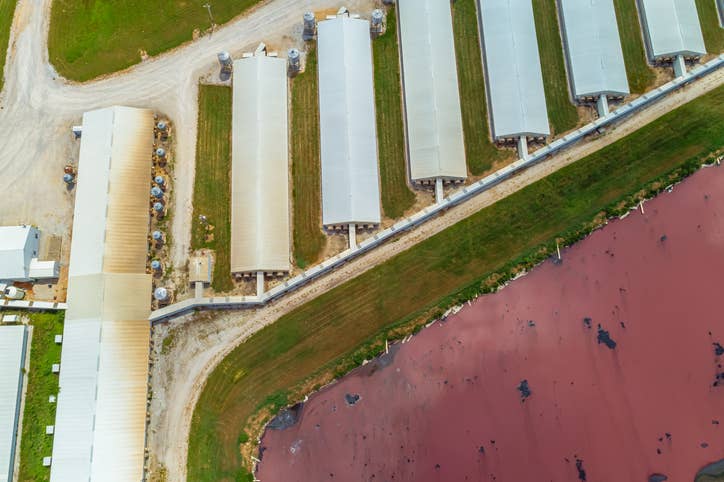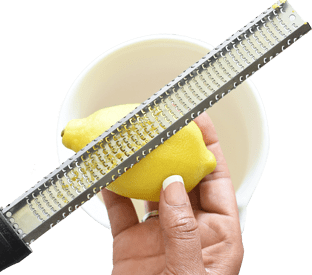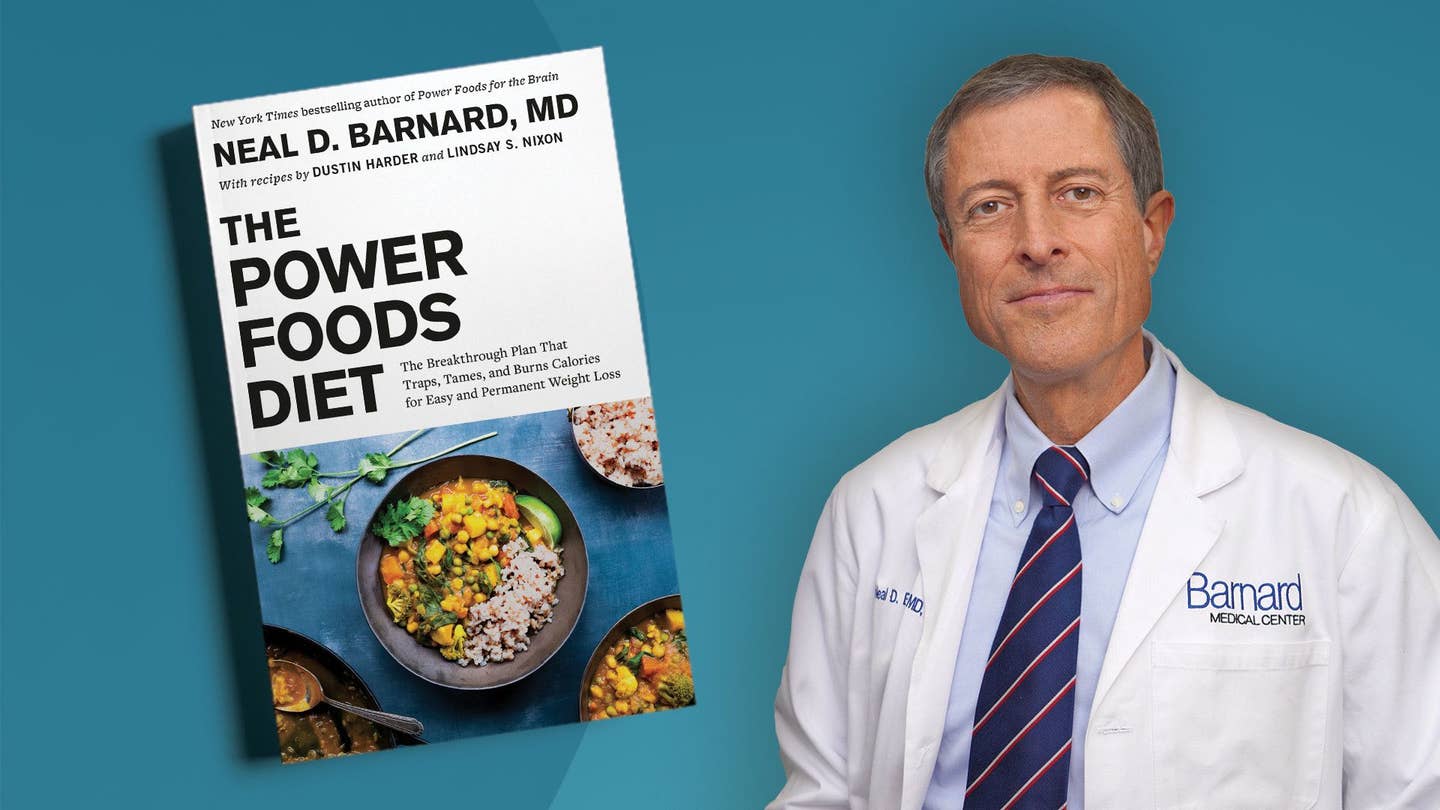Today, Americans consume an enormous amount of dairy. The intake of the average American is estimated to be over 600 pounds of dairy products per year.[1]
Dairy foods (including cow’s milk) have not been part of the diet of adults for the vast majority of human evolution.[2] We’ve only been consuming these foods for about 7,500 years,[3] compared to the roughly 200,000 years humans have been around (with our basic biochemical functionality evolving still a few million years before that).[4]
Intensive and successful marketing by the dairy industry (including slogans like “Milk – It Does a Body Good” and “Got Milk”) have reinforced a broadly ingrained belief that dairy is good for our health. But is it, really?
Dairy has come under fire and scrutiny from nutritional experts, scientists and physicians for its associations with a number of serious health issues.
1. Even Organic Milk Usually Contains Hormones
Dairy is a significant source of female hormone exposure.[5] Commercial cow’s milk contains large amounts of estrogen and progesterone, which is a serious concern. This is further exacerbated by modern dairy cows being genetically altered to continuously produce milk – even throughout their repeated pregnancies.[5] [6]
Even milk products labeled “organic” or “no hormones added” usually contain high levels of these problematic hormones, which are naturally produced by cows (even if those cows have not been given any additional hormones for purposes of the product label).
- In both adults and children, milk consumption has resulted in markedly increased levels of estradiol and progesterone in blood and urine,[6] and dairy consumption in general has been associated with increased levels of circulating estradiol.[7]
- The data show that men who drink milk will absorb the estrogens in the milk, which has been found to result in significantly decreased testosterone production/levels.[6]
- Pediatricians have expressed concern regarding childhood exposure to the exogenous estrogens in commercial milk, given studies showing that early sexual maturation in prepubescent children can be caused by the “ordinary intake of cow milk.”[6]
- A broad array of multi-centered, peer-reviewed studies has shown that dairy consumption is one of the most concerning and consistent risk factors for hormone-dependent malignant diseases, including ovarian, uterine, breast, testicular and prostate cancers.[5-15]
Also, while there is a culturally popular idea that soy foods may cause feminizing effects, several studies have found that isoflavones (the plant-derived compounds in soybeans with estrogenic activity) do not exert feminizing effects on men, even at high consumption levels.[16] Other studies have found that soy food consumption is even protective against breast cancer.[17] [18] I think we should be far more concerned about the high levels of real female sex hormones found in dairy, the consumption of which results in measurably higher circulating levels of these problematic hormones.[5]
2. Casein From Dairy = Increased Risk of Cancer Development
Casein is the main protein in dairy, and studies have shown that it facilitates the growth and development of cancer. In fact, some studies even found that cancer development could be controlled more by casein levels in diet than by exposure to the underlying carcinogen.[19]
Insulin-like growth factor-1 (or IGF-1), a hormone that promotes cell growth and division in both normal and cancer cells, is thought to be one of the mechanisms responsible for this association. IGF-1 appears to be nutritionally regulated, and animal protein consumption (including casein from dairy foods) leads to higher circulating levels of this cancer-promoting hormone. For this reason, consuming casein from dairy (as well as animal protein in general) is associated with increased risk of cancer development and proliferation.[19-25]
3. Higher Risk of Type 1 Diabetes and Multiple Sclerosis
Our immune system normally protects us from microbes and other harmful substances. But if it loses its ability to recognize and distinguish harmful substances from normal tissues and cells, it can instead mount attacks against our own bodies.
These “auto-attacks” can be triggered by exposure to foreign peptides (including animal protein fragments found in dairy), which have similarities to components in the human body. This can result in our immune system becoming “confused” and misidentifying tissues in our body as “foreign” and thus in need of being attacked and destroyed.
Dairy is associated with increased risk of several immune-related disorders (from allergic conditions to autoimmune diseases), many being life-changing and difficult to treat. The associations with type 1 diabetes and multiple sclerosis are particularly concerning:
- Type 1 Diabetes. In type 1 diabetes (also called juvenile diabetes or insulin-dependent diabetes mellitus (IDDM)), the immune system attacks the pancreas, resulting in the body no longer being able to produce insulin to regulate glucose. Multiple large-scale studies have identified an association between cow’s milk consumption and increased prevalence of type 1 diabetes.[26-30] One such study found that “cows’ milk may contain a triggering factor for the development of IDDM,”[26] and another found that “[e]arly cow’s milk exposure may be an important determinant of subsequent type 1 diabetes and may increase the risk approximately 1.5 times.”[27]
- Multiple Sclerosis. In multiple sclerosis (MS), the immune system attacks the insulating sheath of our own nervous system, resulting in a variety of difficult-to-treat and unpredictable neurologic problems. As with type 1 diabetes, numerous studies have reported that cow’s milk consumption may be a significant risk factor for developing MS.[31] [32] [33]
4. Even Pasteurized Milk Contains Microorganisms
Milk and other dairy products are important vehicles for foodborne pathogens due to a variety of microorganisms they harbor.[34] Even with modern sanitation requirements, including pasteurization and curing, outbreaks still occur, resulting in severe and sometimes even fatal outcomes.
Salmonella, Listeria, and E. coli are some of the more common foodborne outbreaks associated with dairy.[35] Just last year, for example, three people tragically died from Listeria infections linked to Blue Bell Ice Cream (prompting a large-scale recall by Blue Bell Creameries).[36] [37]
Not even our food regulatory agencies expect milk will be sterile after pasteurization; the heating process is done merely to reduce (not eliminate) the amount of microorganisms.
5. Dairy Products Accumulate Pesticides in High Concentrations
Exposure to organochlorine pesticides (OCP) is another problem associated with dairy. While pesticide contamination affects water and agricultural lands generally, dairy products have a greater capacity to accumulate these pesticides in higher concentrations, due in part to their high fat content.[38] [39]
Even pesticides that have long been banned still show up when dairy products are tested. Some OCPs (like DDT, which was widely used in the past and now banned as a human carcinogen) still persist in the environment and can more easily accumulate in animal food products, including dairy.
In India, milk and other dairy products (like cheese and butter) have been reported as the major sources of dietary DDT and hexachlorocyclohexane (HCH),[40] and routine monitoring detected that milk from dairy farms in Italy’s Sacco River Valley had levels of ß-HCH twenty times higher than the legal limit.[41]
6. Increased Exposure to Antibiotic Residue
The largest use of antibiotics worldwide is for livestock.[42] Much of that use is for non-therapeutic purposes, such as infection prevention and to promote feed efficiency and animal growth.[43]
Apart from the dire warnings from scientists that agricultural overuse is leading to antibiotic resistance,[44] [45] another problem is that antibiotic residues persist in milk and other dairy products despite protocols aimed to minimize this.
It is difficult to prevent and control these antibiotic residues because milk from individual cows and farms is usually pooled together, and the administration, handling and record-keeping of animal drug use can vary significantly from one dairy operation to another.[46]
The resulting low-dose antibiotic exposure can lead to a variety of problems, from developing antibiotic resistance to allergic reactions to experiencing side-effects of the medication to which a person is exposed.
7. Dairy Can Lead to Bone Problems Too
This may come as a surprise to many, but dairy does not appear to be good for bone health, either.
Not only has the body of scientific evidence been found inadequate to support the idea that dairy consumption promotes bone health,[47] but numerous large-scale studies have found that consuming dairy may actually be detrimental to bone health.[48-51] In fact, there is substantial data linking higher milk intake with significantly increased risk of bone fractures.[48] [49] [50] [51]
There are several mechanisms thought to be responsible for the pathophysiology. One is dairy’s high calcium content, which can cause vitamin D dysregulation and therefore disrupt bone homeostasis. Another is that the high animal protein content of dairy can induce acidosis from its high proportion of sulfur-containing amino acids, which in turn leads to the body compensating by leaching calcium from the bones to help neutralize the increased acidity. Over time, all of this can have a detrimental effect on bone health.[49-60]
While several other factors, such as physical activity, can affect bone health, it’s significant to note that the U.S. has one of the highest rates of hip fractures in the world, despite our high milk intake. By contrast, in countries like Japan and Peru, where average daily calcium intake is as low as 300 milligrams per day (less than a third of the U.S. daily recommendation for adults), the incidence of bone fractures is actually quite low.[48] [49] [61]
Fortunately, calcium is abundant in plant foods, including leafy green vegetables, legumes and seeds, often with higher absorption rates than the calcium in dairy—and of course without all of dairy’s associated health problems.
(RELATED: Getting Clarity About Calcium)
CONCLUSIONS
Each mammalian species produces milk for its own babies, and the content of proteins, fats, carbohydrates and minerals is specific to provide optimum nutrition for a baby of that particular species. The milk from an elephant, tiger, sea lion and cow are each different from one another, and they are all different from human milk.
When we think about it, the health problems associated with consuming the milk and dairy products of other species should not come as any surprise. No other species consumes milk regularly past the weaning period and certainly not from another species—and, as mentioned above, we humans have also not being doing so for the vast majority of our own evolutionary history.
Fortunately, with plant milks, such as soy, almond and rice now available, as well as delicious plant-based versions of other dairy products, it’s never been easier or more convenient to completely avoid dairy.
View Sources
[1] “[W]e consume about 630 pounds of milk, yogurt, cheese and ice cream per year.” A Aubrey. The Average American Ate (Literally) A Ton This Year. NPR.org; 2011 Dec. Available here: http://www.npr.org/sections/thesalt/2011/12/31/144478009/the-average-american-ate-literally-a-ton-this-year (accessed Jan. 31, 2016).
[2] RL Weinsier and CL Krumdieck. Dairy Foods and Bone Health: Examination of the Evidence. Am J Clin Nutr; 2000 Sep; 72(3):681-9. Available here: http://www.ncbi.nlm.nih.gov/pubmed/10966884 (accessed Jan. 31, 2016).
[3] A Curry. Archaeology: The Milk Revolution. Nature; 2013 Jul. Available here: http://www.nature.com/news/archaeology-the-milk-revolution-1.13471 (accessed Jan. 31, 2016).
[4] A study of gene mutations in apes suggests that “[h]umanity's genetic split from an ape-like ancestor came about 13 million years ago”, which is even earlier than the consensus previously suggested by the fossil record “that the last common ancestor of the two species…lived some seven million years ago.” D Vergano. Ancient Human-Chimp Link Pushed Back Millions of Year. National Geographic; 2008 Jun. Available here: http://news.nationalgeographic.com/news/2014/06/140612-chimp-father-evolution-human-science (accessed Jan. 31, 2016).
[5] D Ganmaa and A Sato. The Possible Role of Female Sex Hormones in Milk from Pregnant Cows in the Development of Breast, Ovarian and Corpus Uteri Cancers. Med Hypotheses; 2005; 65(6):1028-37. Available here: http://www.ncbi.nlm.nih.gov/pubmed/16125328 (accessed Jan. 31, 2016).
[6] K Maruyama, T Oshima and K Ohyama. Exposure to Exogenous Estrogen through Intake of Commercial Milk Produced from Pregnant Cows. Pediatr Int; 2010 Feb; 52(1):33-8. Available here: http://www.ncbi.nlm.nih.gov/pubmed/19496976 (accessed Jan. 31, 2016).
[7] MT Brinkman, L Baglietto, K Krishnan, DR English, G Severi, HA Morris, JL Hopper and GG Giles. Consumption of Animal Products, their Nutrient Components and Postmenopausal Circulating Steroid Hormone Concentrations. Eur J Clin Nutr; 2010 Feb; 64(2):176-83. Available here: http://www.ncbi.nlm.nih.gov/pubmed/19904296 (accessed Jan. 31, 2016).
[8] JM Genkinger, DJ Hunter, D Spiegelman, KE Anderson, A Arslan, WL Beeson, JE Buring, GE Fraser, JL Freudenheim, RA Goldbohm, SE Hankinson, DR Jacobs, Jr., A Koushik, JV Lacey, Jr., SC Larsson, M Leitzmann, ML McCullough, AB Miller, C Rodriguez, TE Rohan, LJ Schouten, R Shore, E Smit, A Wolk, SM Zhang and SA Smith-Warner. Dairy Products and Ovarian Cancer: A Pooled Analysis of 12 Cohort Studies. Cancer Epidemiol Biomarkers Prev; 2006 Feb; 15(2):364-72. Available here: http://www.ncbi.nlm.nih.gov/pubmed/16492930 (accessed Jan. 31, 2016).
[9] JM Chan, EL Giovannucci. Dairy Products, Calcium, and Vitamin D and Risk of Prostate Cancer. Epidemiol Rev; 2001;23(1):87-92. Available here: http://www.ncbi.nlm.nih.gov/pubmed/11588859 (accessed Jan. 31, 2016).
[10] E Giovannucci. Dietary Influences of 1,25(OH)2 Vitamin D in Relation to Prostate Cancer: A Hypothesis. Cancer Causes Control; 1998 Dec; 9(6):567-82. Available here: http://www.ncbi.nlm.nih.gov/pubmed/10189042 (accessed Jan. 31, 2016).
[11] JM Chan, MJ Stampfer, J Ma, PH Gann, JM Gaziano and EL Giovannucci. Dairy Products, Calcium, and Prostate Cancer Risk in the Physicians' Health Study. Am J Clin Nutr; 2001 Oct; 74(4):549-54. Available here: http://www.ncbi.nlm.nih.gov/pubmed/11566656 (accessed Jan. 31, 2016).
[12] LQ Qin, JY Xu, PY Wang, J Tong and K Hoshi. Milk Consumption is a Risk Factor for Prostate Cancer in Western Countries: Evidence from Cohort Studies. Asia Pac J Clin Nutr; 2007; 16(3):467-76. Available here: http://www.ncbi.nlm.nih.gov/pubmed/17704029 (accessed Jan. 31, 2016).
[13] LQ Qin, JY Xu, PY Wang, T Kaneko, K Hoshi and A Sato. Milk Consumption is a Risk Factor for Prostate Cancer: Meta-Analysis of Case-Control Studies. Nutr Cancer; 2004; 48(1):22-7. Available here: http://www.ncbi.nlm.nih.gov/pubmed/15203374 (accessed Jan. 31, 2016).
[14] PL Tate, R Bibb and LL Larcom. Milk Stimulates Growth of Prostate Cancer Cells in Culture. Nutr Cancer; 2011 Nov; 63(8):1361-6. Available here: http://www.ncbi.nlm.nih.gov/pubmed/22043817 (accessed Jan. 31, 2016).
[15] D Ganmaa, XM Li, J Wang, LQ Qin, PY Wang and A Sato. Incidence and Mortality of Testicular and Prostatic Cancers in relation to World Dietary Practices. Int J Cancer; 2002 Mar 10; 98(2):262-7. Available here: http://www.ncbi.nlm.nih.gov/pubmed/11857417 (accessed Jan. 31, 2016).
[16] M Messina. Soybean Isoflavone Exposure Does Not Have Feminizing Effects on Men: A Critical Examination of the Clinical Evidence. Fertil Steril. 2010 May; 93(7):2095-104. Available here: http://www.ncbi.nlm.nih.gov/pubmed/20378106 (Accessed Feb. 6, 2016).
[17] XO Shu, F Jin, Q Dai, W Wen, JD Potter, LH Kushi, Z Ruan, YT Gao and W Zheng. Soyfood Intake During Adolescence and Subsequent Risk of Breast Cancer among Chinese Women. Cancer Epidemiol Biomarkers Prev. 2001 May; 10(5):483-8. Available here: http://www.ncbi.nlm.nih.gov/pubmed/11352858 (Accessed Feb. 6, 2016).
[18] AH Wu, P Wan, J Hankin, CC Tseng, MC Yu and MC Pike. Adolescent and Adult Soy Intake and Risk of Breast Cancer in Asian-Americans. Carcinogenesis. 2002 Sep; 23(9):1491-6. Available here: http://www.ncbi.nlm.nih.gov/pubmed/12189192 (accessed Feb. 6, 2016).
[19] GE Dunaif and TC Campbell. Relative Contribution of Dietary Protein Level and Aflatoxin B1 Dose in Generation of Presumptive Preneoplastic Foci in Rat Liver. J Natl Cancer Inst. 1987 Feb; 78(2):365-9. Available here: http://www.ncbi.nlm.nih.gov/pubmed/3100852 (accessed Feb. 6, 2016).
[20] LD Youngman and TC Campbell. Inhibition of Aflatoxin B1-Induced Gamma-Glutamyltranspeptidase Positive (GGT+) Hepatic Preneoplastic Foci and Tumors by Low Protein Diets: Evidence that Altered GGT+ Foci Indicate Neoplastic Potential. Carcinogenesis. 1992 Sep; 13(9):1607-13. Available here: http://www.ncbi.nlm.nih.gov/pubmed/1356651 (accessed Feb. 6, 2016).
[21] TC Campbell. Dietary Protein, Growth Factors, and Cancer. Am J Clin Nutr. 2007; 85:1667. Available here: http://ajcn.nutrition.org/content/85/6/1667.full (accessed Feb. 6, 2016).
[22] D Ornish, G Weidner, WR Fair, R Marlin and EB Pettengill, CJ Raisin, S Dunn-Emke, L Crutchfield, FN Jacobs, RJ Barnard, WJ Aronson, P McCormac, DJ McKnight, JD Fein, AM Dnistrian, J Weinstein, TH Ngo, NR Mendell, PR Carroll. Intensive Lifestyle Changes May Affect the Progression of Prostate Cancer. J Urol. 2005 Sep; 174(3):1065-9. Available here: http://www.ncbi.nlm.nih.gov/pubmed/16094059 (accessed Feb. 6, 2016).
[23] DL Kleinberg, TL Wood, PA Furth and AV Lee. Growth Hormone and Insulin-Like Growth Factor-I in the Transition from Normal Mammary Development to Preneoplastic Mammary Lesions. Endocr Rev. 2009 Feb; 30(1):51-74. doi: 10.1210/er.2008-0022. Available here: http://www.ncbi.nlm.nih.gov/pubmed/19075184 (accessed Feb. 6, 2016).
[24] NE Allen, PN Appleby, GK Davey, R Kaaks, S Rinaldi and TJ Key. The Associations of Diet with Serum Insulin-Like Growth Factor I and its Main Binding Proteins in 292 Women Meat-Eaters, Vegetarians, and Vegans. Cancer Epidemiol Biomarkers Prev. 2002 Nov; 11(11):1441-8. Available here: http://www.ncbi.nlm.nih.gov/pubmed/12433724 (accessed Feb. 6, 2016).
[25] MF McCarty. Vegan Proteins May Reduce Risk of Cancer, Obesity, and Cardiovascular Disease by Promoting Increased Glucagon Activity. Med Hypotheses. 1999 Dec; 53(6):459-85. Available here: http://www.ncbi.nlm.nih.gov/pubmed/10687887 (accessed Feb. 6, 2016).
[26] K Dahl-Jørgensen, G Joner and KF Hanssen. Relationship Between Cows’ Milk Consumption and Incidence of IDDM in Childhood. Diabetes Care. 1991 Nov; 14(11):1081-3. Available here: http://www.ncbi.nlm.nih.gov/pubmed/1797491 (accessed Feb. 6, 2016).
[27] HC Gerstein. Cow’s Milk Exposure and Type I Diabetes Mellitus. A Critical Overview of the Clinical Literature. Diabetes Care. 1994 Jan; 17(1):13-9. Available here: http://www.ncbi.nlm.nih.gov/pubmed/8112184 (accessed Feb. 6, 2016).
[28] SM Virtanen, L Räsänen, A Aro, J Lindström, H Sippola, R Lounamaa, L Toivanen, J Tuomilehto and HK Akerblom. Infant Feeding in Finnish Children less than 7 yr of Age with Newly Diagnosed IDDM. Childhood Diabetes in Finland Study Group. Diabetes Care. 1991 May; 14(5):415-7. Available here: http://www.ncbi.nlm.nih.gov/pubmed/2060453 (accessed Feb. 6, 2016).
[29] E Savilahti, HK Akerblom, VM Tainio and S Koskimies. Children with Newly Diagnosed Insulin Dependent Diabetes Mellitus have Increased Levels of Cow’s Milk Antibodies. Diabetes Res. 1988 Mar; 7(3):137-40. Available here: http://www.ncbi.nlm.nih.gov/pubmed/3416556 (accessed Feb. 6, 2016).
[30] J Karjalainen, JM Martin, M Knip, J Ilonen, BH Robinson, E Savilahti, HK Akerblom and HM Dosch. A Bovine Albumin Peptide as a Possible Trigger of Insulin-Dependent Diabetes Mellitus. N Engl J Med. 1992 Jul 30; 327(5):302-7. Available here: http://www.ncbi.nlm.nih.gov/pubmed/1377788 (accessed Feb. 6, 2016).
[31] D Malosse, H Perron, A Sasco and JM Seigneurin. Correlation Between Milk and Dairy Product Consumption and Multiple Sclerosis Prevalence: A Worldwide Study. Neuroepidemiology. 1992; 11(4-6):304-12. Available here: http://www.ncbi.nlm.nih.gov/pubmed/1291895 (accessed Feb. 6, 2016).
[32] BW Agranoff and D Goldberg. Diet and the Geographical Distribution of Multiple Sclerosis. Lancet. 1974 Nov 2; 2(7888):1061-6. Available here: http://www.ncbi.nlm.nih.gov/pubmed/4138048 (accessed Feb. 6, 2016).
[33] J Butcher. The Distribution of Multiple Sclerosis in Relation to the Dairy Industry and Milk Consumption. N Z Med J. 1976 Jun 23; 83(566):427-30. Available here: http://www.ncbi.nlm.nih.gov/pubmed/1067488 (accessed Feb. 6, 2016).
[34] SP Oliver, BM Jayarao and RA Almeida. Foodborne Pathogens in Milk and the Dairy Farm Environment: Food Safety and Public Health Implications. Foodborne Pathog Dis. 2005 Summer; 2(2):115-29. Available here: http://www.ncbi.nlm.nih.gov/pubmed/15992306 (accessed Feb. 6, 2016).
[35] SF Altekruse, BB Timbo, JC Mowbray, NH Bean and ME Potter. Cheese-Associated Outbreaks of Human Illness in the United States, 1973 to 1992: Sanitary Manufacturing Practices Protect Consumers. J Food Prot. 1998 Oct; 61(10):1405-7. Available here: http://www.ncbi.nlm.nih.gov/pubmed/9798166 (accessed Feb. 6, 2016).
[36] Centers for Disease Control and Prevention website: CDC – Listeria (Listeriosis) – Outbreaks – Multistate Outbreak of Listeriosis Linked to Blue Bell Creameries Products (Final Update). Available here: http://www.cdc.gov/listeria/outbreaks/ice-cream-03-15 (accessed Feb. 6, 2016).
[37] U.S. Food and Drug Administration website: Food – Recalls, Outbreaks & Emergencies – Outbreaks – FDA Investigates Listeria monocytogenes in Ice Cream Products from Blue Bell Creameries. Available here: http://www.fda.gov/Food/RecallsOutbreaksEmergencies/Outbreaks/ucm438104.htm (accessed Feb. 6, 2016).
[38] MI Chubirko, GM Smol'skiĭ, and GM Basova. The Effect of Pesticides on Dairy Product Quality. Gig Sanit. 1998 Mar-Apr; (2):23-5. Available here: http://www.ncbi.nlm.nih.gov/pubmed/9680743 (accessed Feb. 6, 2016).
[39] NM Salem, R Ahmad and H Estaitieh. Organochlorine Pesticide Residues in Dairy Products in Jordan. Chemosphere. 2009 Oct; 77(5):673-8. Available here: http://www.ncbi.nlm.nih.gov/pubmed/19695668 (accessed Feb. 6, 2016).
[40] K Kannan, S Tanabe, JP Giesy and R Tatsukawa. Organochlorine Pesticides and Polychlorinated Biphenyls in Foodstuffs from Asian and Oceanic Countries. Rev Environ Contam Toxicol. 1997; 152:1-55. Available here: http://www.ncbi.nlm.nih.gov/pubmed/9297984 (accessed Feb. 6, 2016).
[41] M Sala, A Caminiti, P Rombolà, A Volpe, C Roffi, O Caperna, M Miceli, A Ubaldi, A Battisti and P Scaramozzino. Beta-Hexachlorocyclohexane Contamination in Dairy Farms of the Sacco River Valley, Latium, Italy, 2005. A Retrospective Cohort Study. Epidemiol Prev. 2012 Sep-Oct; 36 (5 Suppl 4): 34-43. Available here: http://www.ncbi.nlm.nih.gov/pubmed/23139187 (accessed Feb. 6, 2016).
[42] EK Silbergeld, J Graham and JB Price. Industrial food animal production, antimicrobial resistance, and human health. Annu Rev Public Health. 2008; 29:151-69. Available here: http://www.ncbi.nlm.nih.gov/pubmed/18348709 (accessed Feb. 6, 2016).
[43] H Steinfeld, P Gerber, T Wassenaar, V Castel, M Rosales and C de Haan. Livestock’s Long Shadow – Environmental Issues and Options. United Nations, Food and Agriculture Organization. 2006 Nov. Available here: http://www.fao.org/docrep/010/a0701e/a0701e00.HTM (accessed Feb. 6, 2016).
[44] K McVeigh. Scientists: Overuse of Antibiotics in Animal Agriculture Endangers Humans. The Guardian. Available here: https://www.theguardian.com/science/2012/sep/19/scientists-antibiotics-animal-agriculture (accessed Feb. 6, 2016).
[45] MJ Gilchrist, C Greko, DB Wallinga, GW Beran, DG Riley and PS Thorne. The Potential Role of Concentrated Animal Feeding Operations in Infectious Disease Epidemics and Antibiotic Resistance. Environ Health Perspect. 2007 Feb; 115(2): 313–316. Available here: https://www.ncbi.nlm.nih.gov/pmc/articles/PMC1817683 (accessed Feb. 6, 2016).
[46] MR Talley. The National Milk Safety Program and Drug Residues in Milk. Vet Clin North Am Food Anim Pract. 1999 Mar; 15(1):63-73. Available here: http://www.ncbi.nlm.nih.gov/pubmed/10088212 (accessed Feb. 6, 2016).
[47] RL Weinsier and CL Krumdieck. Dairy Foods and Bone Health: Examination of the Evidence. Am J Clin Nutr. 2000 Sept; vol. 72 no. 3 681-689. Available here: http://www.ncbi.nlm.nih.gov/pubmed/10966884 (accessed Feb. 7, 2016).
[48] DM Hegsted. Calcium and Osteoporosis. J Nutr. 1986 Nov; 116(11):2316-9. Available here: http://www.ncbi.nlm.nih.gov/pubmed/3794834 (accessed Feb. 8, 2016).
[49] Harvard T.H. Chan, School of Public Health: The Nutrition Source – Calcium and Milk: What’s Best for Your Bones and Health? Available here: http://www.hsph.harvard.edu/nutritionsource/calcium-full-story (accessed Feb. 8, 2016).
[50] K Michaëlsson, A Wolk, S Langenskiöld, S Basu, EW Lemming, H Melhus and L Byberg. Milk Intake and Risk of Mortality and Fractures in Women and Men: Cohort Studies. BMJ. 2014; 349:g6015. Available here: http://www.ncbi.nlm.nih.gov/pubmed/25352269 (accessed Feb. 8, 2016).
[51] D Feskanich, HA Bischoff-Ferrari, L Frazier and WC Willett. Milk Consumption During Teenage Years and Risk of Hip Fractures in Older Adults. JAMA Pediatr. 2014 Jan; 168(1): 54–60. Available here: http://www.ncbi.nlm.nih.gov/pmc/articles/PMC3983667 (accessed Feb. 8, 2016).
[52] E Giovannucci. Dietary Influences of 1,25(OH)2 Vitamin D in Relation to Prostate Cancer: A hypothesis. Cancer Causes Control. 1998 Dec; 9(6):567-82. Available here: http://www.ncbi.nlm.nih.gov/pubmed/10189042 (accessed Feb. 11, 2016).
[53] HC Sherman and AO Gettler. The Balance of Acid-Forming and Base-Forming Elements in Foods, and its Relation to Ammonia Metabolism. J. Biol. Chem. 1912 11: 323-338. Available here: http://www.jbc.org/content/11/4/323.citation (accessed Feb. 11, 2016).
[54] HC Sherman, AR Rose and MS Rose. Calcium Requirement of Maintenance in Man. J. Biol. Chem. 1920 44: 21-27. Available here http://www.jbc.org/content/44/1/21.citation (accessed Feb. 11, 2016).
[55] BJ Abelow, TR Holford and KL Insogna. Cross-cultural Association between Dietary Animal Protein and Hip Fracture: A hypothesis. Calcif Tissue Int. 1992 Jan;50(1):14-8. Available here: http://www.ncbi.nlm.nih.gov/pubmed/1739864 (accessed Feb. 11, 2016).
[56] D Feskanich, WC Willett, MJ Stampfer, GA Colditz. Protein Consumption and Bone Fractures in Women. Am J Epidemiol. 1996 Mar 1; 143(5):472-9. Available here: http://www.ncbi.nlm.nih.gov/pubmed/8610662 (accessed Feb. 11, 2016).
[57] LA Frassetto, RC Morris Jr., DE Sellmeyer, A Sebastian. Adverse Effects of Sodium Chloride on Bone in the Aging Human Population Resulting from Habitual Consumption of Typical American Diets. Br J Cancer. J Nutr. 2008 Feb; 138(2):419S-422S. Available here: http://www.ncbi.nlm.nih.gov/pubmed/18203914 (accessed Feb. 11, 2016).
[58] MM Adeva, G Souto. Diet-induced Metabolic Acidosis. Clin Nutr. 2011 Aug; 30(4):416-21. Available here: http://www.ncbi.nlm.nih.gov/pubmed/21481501 (accessed Feb. 11, 2016).
[59] US Barzel, LK Massey. Excess Dietary Protein can Adversely Affect Bone. J Nutr. 1998 Jun;128(6):1051-3. Available here: http://www.ncbi.nlm.nih.gov/pubmed/9614169 (accessed Feb. 11, 2016).
[60] LM Ausman, LM Oliver, BR Goldin, MN Woods, SL Gorbach, JT Dwyer. Estimated Net Acid Excretion Inversely Correlates with Urine pH in Vegans, Lacto-ovo Vegetarians, and Omnivores. J Ren Nutr. 2008 Sep; 18(5):456-65. Available here: http://www.ncbi.nlm.nih.gov/pubmed/18721741 (accessed Feb. 11, 2016).
[61] TC Campbell and TM Campbell. The China Study. BenBella Books. 2005 Jan.
[62] LA Frassetto, KM Todd, RC Morris and A Sebastian. Worldwide Incidence of Hip Fracture in Elderly Women: Relation to Consumption of Animal and Vegetable Foods. J Gerontol A Biol Sci Med Sci. 2000 Oct; 55(10):M585-92. Available here: http://www.ncbi.nlm.nih.gov/pubmed/11034231 (accessed Feb. 11, 2016).

Related News
Try Our Top-RatedMeal Planner Free

Forks Meal Planner takes the hard work out of making nutritious meals the whole family will enjoy.
SAVE $200 ON OUR ULTIMATE COURSE

Join our best-selling course at a new lower price!



